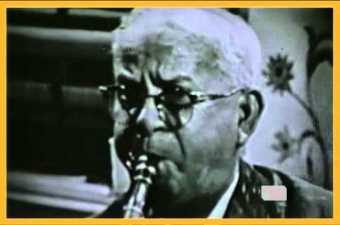Paddock Lounge
309 Bourbon StreetNew Orleans LA 70130
Racehorse owner Steve Valenti opened the Paddock Lounge in 1925. In its early years, floor shows began every hour from 11pm till 8am; the audience for the last one included a mix of people getting off of night shifts at other clubs and 9-to-5ers on their way to day jobs.
After World War II, the Paddock helped promote a revival of traditional New Orleans jazz. Oscar “Papa” Celestin, one of the city’s most popular bandleaders in the first decades of the 20th century, used a regular gig here to support a late-career comeback. After many fallow years he began making radio and television appearances and returned to the studio, recording the locally beloved “Marie LaVeau” shortly before his death in 1954.
One of the pianists who worked with Celestin, Octave Crosby, also led his own group at the Paddock. Clarinetist Alphonse Picou, renown for his solo on the jazz standard “High Society,” got top billing here, too.
The lounge, managed by Valenti’s wife Charlotte, included a kitchen serving seafood and fried chicken and, for a time, featured a revolving stage. At the top every hour, the musicians were required to play “When the Saints Go Marching In,” march outside of the club, and then file back in. The mock parade appealed to audiences increasingly made up of out-of-towners.
As J. Mark Souther points out in New Orleans on Parade: Tourism and the Transformation of the Crescent City, “[midcentury] tourists who went to New Orleans sought encounters with presentations of black jazz that enabled them to retain their preconceived notions.” At places like the Paddock and the Mardi Gras Lounge, this meant bands composed of aged black men like Celestin, Crosby, and Picou, “authentic” artists packaged for white entertainment. (The Paddock may have been the first in a long line of New Orleans establishments to advertise, baselessly, that it was the place where jazz originated.)
Still, until the 1980s, the Paddock employed and raised the profile of scores of musicians who generally lacked the means to reach paying audiences themselves. If access to the market on Bourbon Street entailed playing along with promoters’ gimmicks, many artists took the opportunity to tap a new source of income.
About Bourbon Street
Bourbon Street, one of the most famous streets in the country, is only 14 blocks long, running through the middle of the French Quarter. It took off as an entertainment district in the 1940s, when wartime activity brought waves of visitors to New Orleans. Bands often performed in floor shows featuring burlesque dancers (who stripped to varying degrees), comedians, and other entertainers.
This freewheeling era came to a close, in the eyes of many patrons, with District Attorney Jim Garrison’s vice raids in the early 1960s. Crime — organized and not — was pervasive on Bourbon Street, and Garrison’s crusade scored some political points. The resulting loss of revenue at the clubs, meanwhile, scaled back entertainment budgets.
The only black people on Bourbon Street at the time were there to work (musicians were generally considered hired help; some had to wait in storerooms between sets). Even after the passage of civil rights legislation some clubs resisted integration, and audiences on Bourbon Street remained largely white for years afterward.
In recent decades, as the city relied increasingly on tourism to prop up its economy, the market dictated more changes: Modern stripping supplanted burlesque and DJ booths replaced bandstands. The street became a pedestrian mall, filled with go-cups and Mardi Gras beads year-round. Several clubs sticking with live music offered low wages for bands to play songs familiar to visitors.
Hand-wringing about the quality and nature of live music on the strip has been more or less constant since the 1950s, and not without reason. Still, some venues persisted in hiring reputable artists. In the 2000s, the To Be Continued Brass Band took matters into their own hands, breaking into the scene by playing on the corner of Bourbon and Canal Street every night.
In any case millions of visitors to the strip each year find the spectacle they’re looking for, exotic but approachable, with a more permissive atmosphere than they feel at home. Its economic impact on the city is in the billions. If it’s crass it’s also egalitarian: Bourbon Street today is among the more integrated spaces in town.
Videos

Clarinetist Alphonse Picou plays his famous part in the jazz standard "High Society."
Video posted by Konrad Klingelfuss.
Clarinetist Alphonse Picou plays his famous part in the jazz standard "High Society."
Images




























